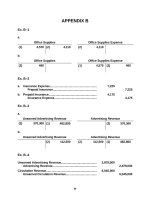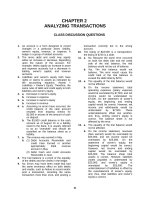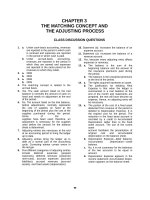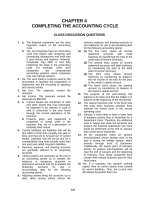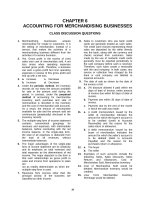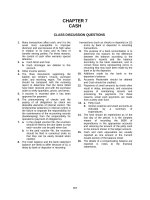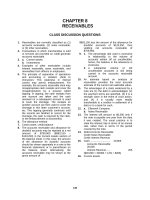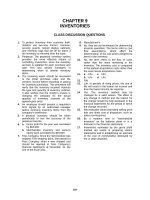Solution manual accounting 21e by warreni ch 23
Bạn đang xem bản rút gọn của tài liệu. Xem và tải ngay bản đầy đủ của tài liệu tại đây (177.39 KB, 48 trang )
CHAPTER 23
PERFORMANCE EVALUATION FOR
DECENTRALIZED OPERATIONS
CLASS DISCUSSION QUESTIONS
1. In the cost center, the department manager
is responsible for and has authority over
costs only. In a profit center, the manager’s
responsibility and authority extend to costs
and revenues.
2. The department manager of a profit center
has responsibility for and authority over
costs and revenues, while the manager of
an investment center has responsibility for
and authority over investments in assets as
well as costs and revenues.
3. The difference in budget performance
reports
prepared
for
department
supervisors and plant managers is the
amount of detail provided to each. The
departmental
supervisors
require
considerable detail to control costs. The
report for the plant managers would
contain more summarized cost data for the
various departments.
4. A cost center manager is not responsible
for making decisions concerning sales or
the amount of fixed assets invested in the
center.
5. Payroll: Number of checks issued.
Accounts payable: Number of invoices
paid. Accounts receivable: Number of sales
invoices
collected.
Database
administration: Number of reports.
6. The major shortcoming of using income
from operations as a measure of
investment center performance is that it
ignores the amount
of investment
committed to each center. Since investment
center managers also control the amount of
assets invested in their centers, they should
be held accountable for the use of invested
assets.
7. Revenues and expenses are considered in
computing the rate of return on investment
because
they
directly
impact
the
determination of income from operations.
Invested assets are considered in
computing the rate of return on investment
because they are the base by which
relative profitability is measured.
8. A division of a decentralized company
could be considered the least profitable,
even though it earned the largest amount
of income from operations, when its rate of
return on investment is the lowest. In this
situation, the division would be considered
the least profitable per dollar invested in
the division.
9. By dividing income from operations by the
amount of invested assets, each division is
placed on a comparable basis of income
from operations per dollar invested.
10. Division A. Division A will return 20 cents
(20%) on each dollar of invested assets,
while Divisions B and C will return only 17
cents and 15 cents, respectively. Thus, in
expanding operations, Division A should be
given priority over Divisions B and C.
11. A balanced scorecard can indicate the
underlying causes of financial performance
from innovation and learning, customer,
internal, and financial perspectives. In
addition, a balanced set of measures helps
managers consider trade-offs between
short-term
and
long-term
financial
performance.
12. The objective of transfer pricing is to
encourage each division manager to work
in the best interests of the company. Thus,
transfer prices should encourage managers
to transfer goods between divisions if the
overall company income can be increased.
13. When unused capacity exists in the
supplying division, the negotiated price
approach is preferred over the market price
approach.
14. Standard cost prevents the transfer of seller
efficiencies or inefficiencies to the
purchasing division, thus isolating cost
performance to each division.
15. The transfer price should be less than the
market price but greater than the supplying
division’s variable cost per unit.
3
EXERCISES
Ex. 23–1
a.
b.
c.
d.
e.
f.
$65,500
$67,150
$1,650
$204,400
$206,450
$2,350
g.
h.
i.
j.
k.
l.
$204,400
$206,450
$2,050
$649,000
$648,950
$2,050
Schedules of supporting calculations (answers in italics; the solution requires
working from the department level, up to the plant level, then to the vicepresident of production level):
AIR-COOL COMPANY
Budget Performance Report—Vice-President, Production
For the Month Ended April 30, 2006
Plant
Budget
St. Louis Plant
Tempe Plant
Syracuse Plant
Actual
$258,900
185,700
204,400 (g)
$649,000 (j)
Over Budget
$257,800
184,700
206,450 (h)
$648,950 (k)
Under Budget
$1,100
1,000
$2,050 (i)
$2,050 (l)
$2,100
AIR-COOL COMPANY
Budget Performance Report—Manager, Syracuse Plant
For the Month Ended April 30, 2006
Department
Compressor Assembly
Electronic Assembly
Final Assembly
Budget
Actual
Over Budget Under Budget
$ 65,500 (a) $ 67,150 (b)
53,200
53,900
85,700
85,400
$204,400 (d) $206,450 (e)
4
$1,650 (c)
700
$2,350 (f)
$300
$300
Ex. 23–1
Concluded
AIR-COOL COMPANY
Budget Performance Report—Supervisor, Compressor Assembly
For the Month Ended April 30, 2006
Department
Factory wages
Materials
Power and light
Maintenance
Budget
Actual
$ 15,400
43,500
2,400
4,200
$ 65,500
$ 16,500
43,200
2,850
4,600
$ 67,150
Over Budget Under Budget
$1,100
$300
450
400
$1,950
$300
b. MEMO
To: Susan Kraft, Vice-President of Production
The Syracuse plant has experienced a $2,050 budget overrun, while the St.
Louis and Tempe plants have experienced budget surpluses. The budget of
the Syracuse plant reveals that the Compressor Assembly Department causes
the majority of the budget overrun. The budget for the Compressor Assembly
Department indicates that the budget overrun was caused by a combination
of budget overruns in wages, power and light, and maintenance that
exceeded a budget surplus in materials. The supervisor of the Compressor
Assembly Department should investigate the reasons for the budget overruns
in wages, power and light, and maintenance. It is possible that all three of
these budget overruns have the same cause, such as a need for unplanned
overtime or weekend work to meet schedules.
Ex. 23–2
HI-VOLT ELECTRICAL EQUIPMENT
Divisional Income Statements
For the Year Ended June 30, 2006
Net sales.............................................................................
Cost of goods sold............................................................
Gross profit........................................................................
Administrative expenses...................................................
Income from operations before service
department charges....................................................
Service department charges.............................................
Income from operations....................................................
5
Residential
Division
$645,000
376,000
$269,000
100,400
Industrial
Division
$402,400
209,800
$192,600
83,200
$168,600
67,800
$100,800
$109,400
31,200
$ 78,200
Ex. 23–3
Expense
a. Duplication services
b. Accounts receivable
c. Electronic data processing
d. Central purchasing
e. Legal
f. Telecommunications
Activity Bases
Number of pages
Number of invoices, number of customers
Central processing unit (CPU) time, number
of printed pages, amount of memory
usage
Number of requisitions, number of purchase orders
Number of hours
Number of lines, number of long-distance
minutes
Ex. 23–4
a.
b.
c.
d.
1
7
6
2
e.
f.
g.
h.
5
4
3
8
6
Ex. 23–5
a.
Residential
Commercial
Highway
Total
Number of payroll checks:
Weekly payroll × 52....................
Monthly payroll × 12...................
Total.......................................
4,160
168
4,328
2,080
132
2,212
3,120
120
3,240
9,780
Number of purchase requisitions
per year.......................................
1,000
850
750
2,600
Service Dept.
Activity
Cost
÷
Base
Service department charge rates:
Payroll Department....................
Purchasing Department.............
$24,450
$10,400
Residential
Service department charges:
Payroll Department.................... $10,820
Purchasing Department.............
4,000
Total....................................... $14,820
÷
÷
9,780
2,600
=
Charge
Rate
=
=
$2.50/check
$4.00/req.
Commercial
Highway
Total
$5,530
3,400
$8,930
$ 8,100
3,000
$ 11,100
$24,450
10,400
The service department charges are determined by multiplying the service
department charge rate by the activity base for each division. For example,
Residential’s service department charges are determined as follows:
Payroll:
$2.50 × 4,328 checks = $10,820
Purchasing: $4.00 × 1,000 purchase requisitions = $4,000
b. Residential’s service department charge is higher than the other two divisions
because Residential is a heavy user of service department services.
Residential has many employees on a weekly payroll, which translates into a
larger number of check-issuing transactions. This may be because residential
jobs are less productive per labor hour, compared to larger commercial and
highway jobs. Additionally, Residential uses purchasing services significantly
more than the other two divisions. This may be because the division has
many different smaller jobs requiring frequent purchase transactions.
7
Ex. 23–6
a.
Help desk:
$33,600
= $32 per call
1,050 calls
Network center:
$273,000
= $65 per device monitored
4,200 devices
Electronic mail:
$23,800
= $8.50 per e-mail account
2,800 accounts
Local voice support:
$56,550
= $14.50 per phone extension
3,900 accounts
b. March charges to the COMM sector:
Help desk charge: (1,800 employees × 50% × 80% × 0.40) × $32/call = $9,216
Network center charge: [(1,800 employees × 50% × 80%) + 200] × $65/device =
$59,800
Electronic mail: (1,800 employees × 50% × 80% × 90%) × $8.50/e-mail account
= $5,508
Local voice support: (1,800 employees × 50%) × $14.50/phone extension =
$13,050
8
Ex. 23–7
ENTERTAINMENT ELECTRONICS COMPANY
Divisional Income Statements
For the Year Ended December 31, 2006
Video Division
Revenues....................................
Cost of goods sold....................
Gross profit................................
Operating expenses...................
Income from operations
before service department
charges..................................
Less service department
charges:
Computer Support
Department............................
Accounts Payable
Department............................
Income from operations............
Audio Division
$ 4,000,000
2,100,000
$ 1,900,000
750,000
$ 3,400,000
1,600,000
$ 1,800,000
700,000
$ 1,150,000
$ 1,100,000
$252,000
$168,000
57,750
$
309,750
840,250
107,250
$
Supporting calculations for controllable service department charges:
Computer Support Department:
($420,000 ÷ 300) × 180 = $252,000
($420,000 ÷ 300) × 120 = $168,000
Accounts Payable Department:
($165,000 ÷ 12,000) × 4,200 = $57,750
($165,000 ÷ 12,000) × 7,800 = $107,250
9
275,250
824,750
Ex. 23–8
a.
The reported income from operations does not accurately measure
performance because the service department charges are based on revenues.
Revenues are not associated with the profit center manager’s use of the
service department services. For example, the Reservations Department
serves only the Passenger Division. Thus, by charging this cost on the basis
of revenues, these costs are incorrectly charged to the Cargo Division.
Additionally, the passenger division requires flight attendants. Since these
flight attendants must be trained, the training costs assigned to the
Passenger Division should be greater than the Cargo Division.
b.
PEGASUS AIRLINES INC.
Divisional Income Statements
For the Year Ended October 31, 2006
Passenger Division
Revenues....................................
Operating expenses...................
Income from operations
before service department
charges..................................
Less service department
charges:
Training (Note 1)...................
Flight scheduling (Note 2)....
Reservations.........................
Income from operations............
$ 3,000,000
1,500,000
$3,000,000
1,250,000
$ 1,500,000
$1,750,000
$400,000
225,000
800,000
$
1,425,000
75,000
Note 1: Passenger Division, ($500,000 ÷ 250) × 200
Cargo Division, ($500,000 ÷ 250) × 50
Note 2: Passenger Division, ($600,000 ÷ 400) × 150
Cargo Division, ($600,000 ÷ 400) × 250
10
Cargo Division
$100,000
375,000
—
475,000
$1,275,000
Ex. 23–9
SIERRA SPORTING GOODS CO.
Divisional Income Statements
For the Year Ended June 30, 2006
Sales...........................................................................
Cost of goods sold....................................................
Gross profit................................................................
Divisional selling expenses......................................
Divisional administrative expenses..........................
Income from operations before service
department charges............................................
Less service department charges:
Advertising expense...........................................
Transportation expense......................................
Accounts receivable collection expense..........
Warehouse expense...........................................
Total.....................................................................
Income from operations............................................
Camping
Equipment
Division
Ski
Equipment
Division
$380,000
205,000
$175,000
$ 60,000
38,800
$ 98,800
$575,000
275,000
$300,000
$ 82,000
51,200
$133,200
$ 76,200
$166,800
$ 11,200
9,120
5,040
40,000
$ 65,360
$ 10,840
$ 14,600
11,020
6,580
20,000
$ 52,200
$114,600
Supporting Schedule:
Service Department Charges
Camping
Division
Ski
Division
Total
Advertising expense.......................................
$ 11,200
$ 14,600
$25,800
Transportation rate per bill of lading.............
Number of bills of lading................................
Transportation expense..................................
$ 3.80
× 2,400
$ 9,120
$ 3.80
× 2,900
$ 11,020
$20,140
Accounts receivable collection rate..............
Number of sales invoices...............................
Accounts receivable collection expense.......
$ 2.80
× 1,800
$ 5,040
$ 2.80
× 2,350
$ 6,580
$11,620
Warehouse rate per sq. ft.
($60,000/15,000 sq. ft.)....................................
Number of square feet....................................
Warehouse expense........................................
$ 4.00
× 10,000
$ 40,000
$ 4.00
× 5,000
$ 20,000
$60,000
11
Ex. 23–10
a.
Cheese Division:
Milk Division:
Butter Division:
13% ($104,000 ÷ $800,000)
25% ($160,000 ÷ $640,000)
24% ($297,600 ÷ $1,240,000)
b. Milk Division
Ex. 23–11
a.
Cheese
Division
Milk
Division
Butter
Division
Income from operations...........................
Minimum amount of income from
operations:
$800,000 × 15%.................................
$640,000 × 15%.................................
$1,240,000 × 15%..............................
$104,000
$160,000
$297,600
Residual income.......................................
$ (16,000)
b. Butter Division
12
120,000
96,000
186,000
$ 64,000
$ 111,600
Ex. 23–12
a.
b.
c.
d.
e.
1.4 (21% ÷ 15%)
14% (8% × 1.75)
24% (18% ÷ 0.75)
1.5 (27% ÷ 18%)
24% (12% × 2.0)
Ex. 23–13
a.
Rate of return on
investment (ROI)
=
Profit margin × Investment turnover
Rate of return on
investment (ROI)
=
Income from operations
Sales
×
Sales
Invested assets
$157,500
$700,000
×
$700,000
$1,250,000
ROI
=
ROI
ROI
=22.5% × 0.56
= 12.6%
b. The profit margin would increase from 22.5% to 28.125%, the investment
turnover would remain unchanged, and the rate of return on investment
would increase from 12.6% to 15.75%, as shown below.
Rate of return on
investment (ROI) = Profit margin × Investment turnover
Rate of return on
investment (ROI)
=
Income from operations
Sales
×
Sales
Invested assets
$196,875
$700,000
×
$700,000
$1,250,000
ROI
=
ROI
ROI
=28.125% × 0.56
= 15.75%
13
Ex. 23–14
a.
Rate of return on investment =
Media Networks:
Income from operations
Revenues
×
Revenues
Invested assets
$986
$9,733
×
$9,733
$26,038
= 10.13% × 0.3738
= 3.79% (rounded)
Parks and Resorts:
$1,169
$6,465
×
$6,465
$11,305
= 18.08% × 0.5719
= 10.34% (rounded)
Studio Entertainment:
$273
$6,662
×
$6,662
$7,879
= 4.10% × 0.8455
= 3.47% (rounded)
Consumer Products:
$394
$2,509
×
$2,509
$1,125
= 15.70% × 2.2302
= 35.01% (rounded)
b. The four sectors are different from each other. Media Networks and Studio
Entertainment both have a rate of return on investment (ROI) below 4%. Media
Networks combines an average profit margin with a very low investment
turnover, while Studio Entertainment has a low profit margin combined with
an average investment turnover. Media Networks is sensitive to advertising
revenue, while the Studio Entertainment sector is sensitive to producing box
office hits. The Parks and Resorts sector has a very high profit margin at 18%
with a fairly low investment turnover. The combination produces a
respectable ROI in excess of 10%. The Consumer Products division combines
a good profit margin with a stellar investment turnover. The combination
produces an excellent ROI of 35%. Much of the consumer product income is
produced from licensing the Disney characters and brands, which requires
very few assets.
14
Ex. 23–15
a.
b.
c.
d.
e.
f.
15% ($77,250 ÷ $515,000)
$61,800 ($515,000 × 12%)
$15,450 ($77,250 – $61,800)
$67,000 ($50,250 + $16,750)
20% ($67,000 ÷ $335,000)
15% ($50,250 ÷ $335,000)
g.
h.
i.
j.
k.
l.
$30,800 ($220,000 × 14%)
16% ($35,200 ÷ $220,000)
($4,400) ($30,800 – $35,200)
12% ($54,000 ÷ $450,000)
$45,000 ($450,000 × 10%)
$9,000 ($54,000 – $45,000)
Ex. 23–16
a.
(a)
(b)
(c)
(d)
(e)
(f)
(g)
(h)
(i)
(j)
(k)
(l)
$58,400 ($365,000 × 16%)
$292,000 ($58,400 ÷ 20%)
1.25 (20% ÷ 16%)
$480,000 ($60,000 ÷ 12.5%)
$750,000 ($480,000 ÷ 0.64)
8% (12.5% × 0.64)
$48,900 ($407,500 × 12%)
15% ($48,900 ÷ $326,000)
0.80 ($326,000 ÷ $407,500)
17.5% ($119,000 ÷ $680,000)
14% ($119,000 ÷ $850,000)
1.25 ($850,000 ÷ $680,000)
b. North Division:
East Division:
South Division:
West Division:
c.
$29,200 [$58,400 – ($292,000 × 10%)]
$(15,000) [$60,000 – ($750,000 × 10%)]
$8,150 [$48,900 – ($407,500 × 10%)]
$51,000 [$119,000 – ($680,000 × 10%)]
(1) The North Division has the highest return on investment (20%).
(2) The West Division has the largest residual income. Even though the West
Division’s rate of return is slightly lower than the North Division’s (17.5%
vs. 20%), the residual income is larger because the investment is large,
relative to the North Division.
15
Ex. 23–17
a.
Rate of return on investment =
Hotel Ownership:
Income from operations
Revenues
×
Revenues
Invested assets
$470
$2,388
×
$2,388
$4,542
= 19.68% × 0.5258
= 10.35% (rounded)
Managing and Franchising:
$290
$342
×
$342
$668
= 84.8% × 0.5120
= 43.42% (rounded)
Timeshare:
$86
$320
×
$320
$333
= 26.88% × 0.9610
= 25.83% (rounded)
Hotel
Managing &
Ownership Franchising
b.
Income from operations......................
Minimum return (15% of assets)........
Residual income..................................
c
$ 470
681
$ (211)
$290
100
$190
Timeshare
$ 86
50
$ 36
The hotel ownership segment has the weakest return on investment (ROI),
which is mainly the result of a weak investment turnover. The hotel earns
good margins at nearly 20%, but the investment in hotel properties is
significant, causing the ROI to be less than the assumed minimum acceptable
return. The residual income is negative, which is consistent with a ROI less
than the 15% minimum return. The other two segments perform very well. The
managing and franchising margins are excellent, since managing and
franchising hotels is a royalty based business that has very few associated
costs. The asset turnover is low because Hilton is often a joint owner of the
franchised or managed hotel. As a result, the ROI for the managed and
franchised division is excellent, and it also has the highest residual income.
The timeshare division has a stronger asset turnover, since others own the
timeshare properties. The division combines the good investment turnover
with a very good profit margin. The net result is excellent ROI of nearly 26%.
The residual income for the division is positive, as would be expected for a
26% ROI.
16
Ex. 23–18
Although there is some judgment in classifying each of these measures, the
following represents our assessment with explanations.
Average cardmember spending
Customer—demonstrates
the
usefulness of the card to the customer.
Cards in force
Customer—if customers did not value
the card, they would not have one.
Earnings growth
Financial
Hours of credit consultant training
Internal process—advisors will do their
job better if they are trained.
Investment in information technology
Internal process (or innovation)—shows
the investment in improving processes.
Number of Internet features
Internal process (or innovation)—shows
new process investments in a new
channel.
Number of merchant signings
Customer—the larger the number of
merchants that honor the card, the more
valuable it is to cardholders.
Number of card choices
Customer—more choices
valuable to customers.
Number of new card launches
Innovation—measures the new cards
(affinity, regional, etc.) being developed
and marketed.
Return on equity
Financial
Revenue growth
Financial
17
are
more
Ex. 23–19
a.
UPS wanted a performance measurement system that would focus more on
the underlying drivers, or levers, of financial success. It believed that
focusing on the financial numbers by themselves would not reveal how
financial objectives were to be achieved, especially with new demands
coming from customers in the Internet age. The balanced scorecard provides
information on how the financial targets are to be achieved. Using common
measures throughout the organization also aligns the organization, while
simultaneously communicating priorities. Apparently, UPS determined that its
future success as an organization depended upon “point of arrival”
measures. These measures emphasized customer performance to a much
higher degree than would straight financial numbers.
b. The employee sentiment number is common in service businesses. The
employees are the face of the company to the customer. If employees feel
poorly about the organization, or if they feel that they don’t make a difference,
then they are not likely to deliver premium service experiences to their
customers. Just think of the variety of fast food experiences you may have
had in the past month. Sometimes, the service is excellent with a smile; at
other times, it’s poor with a scowl. Measuring the improving employee morale
is critical to organizations relying on front-line employees that deliver the
customer experience.
Ex. 23–20
a.
$3,500,000. Monumental Motors’ total income from operations would increase
by the difference between the market price of $260 and the Component
Division’s variable costs per unit of $190, multiplied by 50,000 units.
b. $2,500,000. The Truck Division’s income from operations would increase by
the difference between the market price of $260 and the transfer price of $210,
multiplied by 50,000 units. This is the amount the Truck Division saves by
purchasing from the Component Division at an internal price that is lower
than the market price.
c. $1,000,000. The Component Division’s income from operations would
increase by the difference between the transfer price of $210 and the
Component Division’s variable costs per unit of $190, multiplied by 50,000
units. This is the amount the Component Division earns by using available
excess capacity to produce and sell products above variable cost to the
Truck Division.
18
Ex. 23–21
a.
$3,500,000. Monumental Motors’ total income from operations would increase
by the difference between the market price of $260 and the Component
Division’s variable costs per unit of $190, multiplied by 50,000 units. This
amount is the same amount by which Monumental Motors’ income from
operations increased in Ex. 23–20, when a transfer price of $210 was used.
b. $1,000,000. The Truck Division’s income from operations would increase by
the difference between the market price of $260 and the transfer price of $240,
multiplied by 50,000 units. This is the amount the Truck Division saves by
purchasing from the Component Division at an internal price that is lower
than the market price.
c. $2,500,000. The Component Division’s income from operations would
increase by the difference between the transfer price of $240 and the
Component Division’s variable costs per unit of $190, multiplied by 50,000
units. This is the amount the Component Division earns by using available
excess capacity to produce and sell products above variable cost to the
Truck Division.
d. Any transfer price will cause the total income of the company to increase, as
long as the supplier division capacity is used toward making materials for
products that are ultimately sold to the outside. This is because the transfer
price affects only the profit allocated between the two divisions, not the total
profit. However, transfer prices should be set between variable cost and
selling price in order to give the division managers proper incentives. A
transfer price set below variable cost would cause the supplier division to
incur a loss, while a transfer price set above market price would cause the
purchasing division to incur opportunity costs. Neither situation is an
attractive alternative for an investment center manager. Thus, the general rule
is to negotiate transfer prices between variable cost and selling price when
the supplier division has excess capacity. The range of acceptable transfer
prices for Monumental Motors would be between $190 and $260.
19
PROBLEMS
Prob. 23–1A
1.
Budget Performance Report—Director, International Division
For the Month Ended April 30, 2006
Budget
Software engineer salaries.......
Customer service salaries.......
Logistics salaries.....................
Marketing salaries....................
Warehouse wages....................
Equipment depreciation...........
Insurance and property taxes. .
Total......................................
$155
85
170
240
105
32
23
$810
Actual
$152
109
168
269
101
32
22
$853
Over
Budget
Under
Budget
$ 3
$24
2
29
4
—
$53
1
$10
2. The customer service and marketing salaries are significantly over budget.
The director should investigate the cause of these results. One possibility is
that the company is having an increase in sales, requiring greater marketing
effort and customer service. However, the warehouse and logistics costs
have not shown similar increases. Thus, it’s also possible that marketing and
customer service salaries are increasing because of service problems and
unplanned efforts to market the company’s service.
20
Prob. 23–1A
Concluded
This solution is applicable only if the P.A.S.S. Software that accompanies the text
is used.
INTERNATIONAL DIVISION
Budget Report
For the Period Ended April 30, 2006
Difference
from Budget
Budget
Actual
Operating revenue...........................
Operating expenses:
Software engineer salaries........
Customer service salaries.........
Logistics salaries.......................
Marketing salaries......................
Warehouse wages......................
Equipment depreciation............
Insurance and property tax.......
Total operating expenses.....
$855
$863
$
$155
85
170
240
105
32
23
$810
$152
109
168
269
101
32
22
$853
$ (3)
24
(2)
29
(4)
(1.94)
28.24
(1.18)
12.08
(3.81)
(1)
$ 43
(4.35)
5.31
Net income.......................................
$ 45
$ 10
$ (35)
(77.78)
21
8
%
0.94
Prob. 23–2A
1.
A. G. BELL COMMUNICATIONS COMPANY
Divisional Income Statements
For the Quarter Ended December 31, 2006
Revenue..............................................................
Operating expenses...........................................
Income from operations before service
department charges.....................................
Less service department charges:
Customer support ($12 × customer calls). .
Central accounting
($30 × number of accounting reports)........
Income from operations....................................
Central
Coastal
Metro
$620,000
370,000
$856,000
495,700
$1,180,000
675,200
$250,000
$360,300
$ 504,800
$ 48,000
$ 55,200
$
24,000
$ 72,000
$178,000
42,000
$ 97,200
$263,100
36,000
$ 124,800
$ 380,000
88,800
Supporting schedules:
Service department charge rates for the two service departments, Customer
Support and Central Accounting, are determined as follows:
Central Coastal
Number of customer calls.............
Number of accounting reports......
4,000
800
Service
Cost
Metro
4,600
1,400
Total
7,400
1,200
÷
Output
=
Customer call rate.......................... $192,000 ÷
Accounting report rate.................. 102,000 ÷
16,000
3,400
=
=
16,000
3,400
Rate
$12.00 per call
30.00 per report
Note: The Shareholder Relations Department and general corporate officers’
salaries are not controllable by division management and thus are not included in
determining division income from operations.
22
Prob. 23–2A
Concluded
2. The CEO evaluates the three divisions using income from operations as a
percent of revenues (profit margin). This measure is calculated for the three
divisions as follows:
Central Division: 28.71% ($178,000 ÷ $620,000)
Coastal Division: 30.74% ($263,100 ÷ $856,000)
Metro Division: 32.20% ($380,000 ÷ $1,180,000)
According to the CEO’s measure, the Metro Division has the highest
performance.
3.
To: CEO
The method used to evaluate the performance of the divisions should be
reevaluated. The present method identifies the amount of income from
operations per dollar of earned revenue. However, this communications
company requires a significant investment in fixed assets, such as fiber optic
cable and switches. In addition, the amount of assets may not be related to
the revenue earned. For example, some regions are able to concentrate
assets in a densely populated regional area and provide extensive
communication services over those assets (e.g., Metro Division). Other
regions, however, have widely distributed assets over sparsely populated
areas that use less services over those assets. The present measure fails to
incorporate these differences in asset utilization into the measure. Naturally,
the amount of assets used by a division in earning a return is a very important
consideration in evaluating divisional performance. Therefore, a better
divisional performance measure would be either (a) rate of return on
investment (income from operations divided by divisional assets) or (b)
residual income (income from operations less a minimal return on divisional
assets). Both measures incorporate the assets used by the divisions.
23
Prob. 23–3A
1.
HEARTY MORNING FOOD COMPANY
Divisional Income Statements
For the Year Ended June 30, 2006
Sales.....................................................
Cost of goods sold.............................
Gross profit.........................................
Operating expenses............................
Income from operations......................
2.
Fruit Juice
Division
Bread
Division
$1,050,000
760,000
$ 290,000
164,000
$ 126,000
$1,400,000
900,000
$ 500,000
290,000
$ 210,000
$800,000
520,000
$280,000
120,000
$160,000
Rate of return on
investment (ROI)
=Profit margin × Investment turnover
Rate of return on
investment (ROI)
=
Cereal Division:
ROI
ROI
Sales
Income from operations
×
Sales
Invested assets
ROI =
ROI
ROI
Bread Division:
ROI
ROI
$126,000
$1,050,000
×
$1,050,000
$1,250,000
=12% × 0.84
=10.08%
Fruit Juice Division: ROI =
3.
Cereal
Division
$210,000
$1,400,000
×
$1,400,000
$2,000,000
=15% × 0.70
=10.50%
ROI =
$160,000
$800,000
×
$800,000
$640,000
=20% × 1.25
= 25%
Per dollar of invested assets, the Bread Division is the most profitable of the
three divisions. Assuming that the rates of return on investments do not
change in the future, an expansion of the Bread Division will return 25 cents
(25%) on each dollar of invested assets, while the Cereal and Fruit Juice
Divisions will return only 10.08 cents (10.08%) and 10.5 cents (10.5%),
respectively. Thus, when faced with limited funds for expansion, management
should consider an expansion of the Bread Division first.
24
Prob. 23–4A
1.
Rate of return on
investment (ROI)
=Profit margin × Investment turnover
Rate of return on
investment (ROI)
=
Music Division:
ROI
ROI
ROI
Income from operations
Sales
×
Sales
Invested assets
=
$45,100
$410,000
×
$410,000
$256,250
=11% × 1.60
=17.60%
2.
MEMPHIS SOUNDS INC.—MUSIC DIVISION
Estimated Income Statements
For the Year Ended December 31, 2006
Proposal 1
Proposal 2
Proposal 3
Sales......................................................
Cost of goods sold...............................
Gross profit...........................................
Operating expenses.............................
Income from operations.......................
$ 410,000
189,800
$ 220,200
187,400
$ 32,800
$ 410,000
124,200
$ 285,800
187,400
$ 98,400
$ 340,000
138,600
$ 201,400
150,400
$ 51,000
Invested assets.....................................
$ 205,000
$ 512,500
$ 212,500
25
Prob. 23–4A
3.
Concluded
Rate of return on
investment (ROI) =
Profit margin × Investment turnover
Rate of return on
investment (ROI)
=
Income from operations
Sales
×
Sales
Invested assets
Proposal 1: ROI
=
$32,800
$410,000
×
$410,000
$205,000
ROI
ROI
=8% × 2.0
= 16%
Proposal 2: ROI
ROI
ROI
$98,400
$410,000
×
$410,000
$512,500
=24% × 0.80
=19.2%
Proposal 3: ROI
ROI
ROI
=
=
$51,000
$340,000
×
$340,000
$212,500
=15% × 1.6
= 24%
4. Proposal 3 would yield a rate of return on investment of 24%.
5.
Rate of return on investment (ROI) = Profit margin ×
Required investment
turnover
20%
=11% × Required investment turnover
Required Investment Turnover =1.82 (20% ÷ 11%)
Current Investment Turnover
= 1.60
Increase in Investment Turnover = 0.22
or
13.75% Increase (0.22 ÷ 1.60)
26
Prob. 23–5A
1.
SWIFT SHOE COMPANY
Divisional Income Statements
For the Year Ended December 31, 2006
Sales....................................................................
Cost of goods sold.............................................
Gross profit.........................................................
Operating expenses............................................
Income from operations.....................................
2.
Women's
Division
$480,000
275,000
$205,000
115,000
$ 90,000
$620,000
376,000
$244,000
120,000
$124,000
Rate of return on
investment (ROI)
=Profit margin × Investment turnover
Rate of return on
investment (ROI)
=
Men’s Division:
ROI
ROI
Women’s Division:
ROI
ROI
3.
Men's
Division
ROI
Income from operations
Sales
×
Sales
Invested assets
=
$90,000
$480,000
×
$480,000
$400,000
=18.75% × 1.20
=22.5%
ROI
=
$124,000
$620,000
×
$620,000
$775,000
=20% × 0.8
= 16%
Men’s Division: $10,000 [$90,000 – ($400,000 × 20%)]
Women’s Division: ($31,000) [$124,000 – ($775,000 × 20%)]
27
